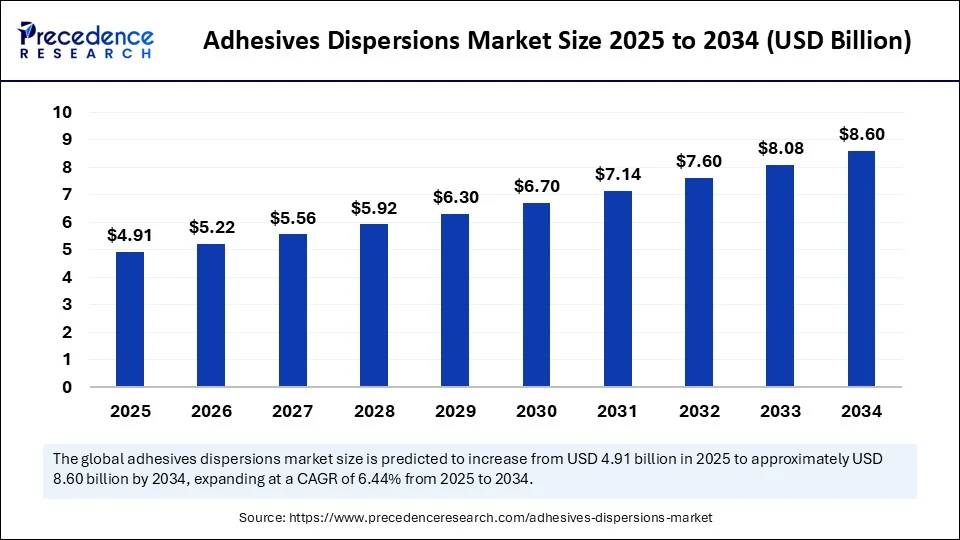Adhesives Dispersions Market Set to Surpass $8.60 Billion by 2034
Eco-Focused Innovations and AI-Driven Efficiency Fuel Sector Growth at 6.44% CAGR
The adhesives dispersions market is eyeing robust growth, poised to grow from $4.91 billion in 2025 to a projected $8.60 billion by 2034. This surge, representing a compound annual growth rate (CAGR) of 6.44% during 2025–2034, is powered by increasing demand for eco-friendly, water-based adhesives especially within packaging, automotive, construction, and textiles.

Adhesives Dispersions Market Quick Insights
-
The adhesives dispersions market was valued at $4.61 billion in 2024 and will reach nearly $8.60 billion by 2034.
-
Asia Pacific is the dominant region, owning more than $2.21 billion of the 2025 market, and will reach $3.91 billion by 2034.
-
North America is the fastest-growing region, spurred by stricter environmental regulations and cutting-edge tech adoption.
-
Leading growth drivers: eco-friendly product demand, high-performance bonding, and regulatory pushes for greener solutions.
-
The packaging & paperboard segment led the end-use market focus in 2024, followed by strong momentum in hygiene and automotive end-users.
-
Top market players (as highlighted) include global and regional manufacturers, but the report does not specify their names on the extracted page.
Get this report to explore global market size, share, CAGR, and trends, featuring detailed segmental analysis and an insightful competitive landscape overview @ https://www.precedenceresearch.com/sample/6588
Revenue Table: Global Adhesives Dispersions Market
| Year | Market Size (USD Billion) |
|---|---|
| 2024 | $4.61 |
| 2025 | $4.91 |
| 2034 | $8.60 |
| CAGR | 6.44% (2025-2034) |
Artificial intelligence is a silent but powerful catalyst in the adhesives dispersions industry. AI-driven analytics are revolutionizing R&D by simulating and optimizing adhesive formulas, cutting down laborious trial-and-error processes. Predictive machine learning algorithms ensure real-time quality monitoring on production lines, catching viscosity and curing anomalies before they impact output, resulting in stronger, more consistent products.
Moreover, AI refines supply chains using procurement forecasts to minimize waste and curtail costs. Its impact extends to sustainability, as algorithms help uncover eco-friendly raw materials and drive energy-efficient manufacturing. The integration of AI delivers high-performance, tailored adhesive solutions for increasingly specialized industries, quickening innovation cycles in packaging, automotive, and healthcare.
What’s Driving Growth in the Adhesives Dispersions Market?
-
Eco-Friendly Momentum: The pivot to water-based, low-VOC formulations continues as end-users and regulators favor sustainable options.
-
Performance Demands: Modern construction, automotive, and packaging require stronger, lightweight, high-performing adhesives.
-
Technology Advancements: Rapid R&D progress yields products with improved curing times, heat/moisture/chemical resistance.
-
Industrialization in Emerging Markets: Fast-industrializing regions boost adhesive adoption as infrastructure and manufacturing expand.
-
End-Use Versatility: Adhesive dispersions are integral to a diverse range of applications—from packaging and construction to automotive interiors and textiles.
What Market Opportunities and Trends Are on the Horizon?
How Will E-Commerce and Flexible Packaging Reshape the Market?
The e-commerce boom is escalating demand for robust, quick-drying adhesives suitable for flexible packaging and corrugated boxes. As circular economy models gain traction, water-based dispersions—compatible with recyclable and compostable materials—are increasingly the adhesive of choice for high-speed, automated packing lines.
Where Are the “Next Billion-Dollar” Regional Opportunities?
Major growth is projected in Asia Pacific, Latin America, and Africa, where urbanization and supportive regulations foster adhesive adoption. North America, meanwhile, leads in innovation, targeting specialty applications in healthcare and lightweighting automotive trends.
Regional and Segmentation Analysis: Where Are the Hotspots?
Regional Performance
| Region | 2025 USD Billion | 2034 USD Billion | CAGR (2025-2034) |
|---|---|---|---|
| Asia Pacific | $2.21 | $3.91 | 6.57% |
| North America | — | — | Fastest growing |
| Europe, LATAM, MEA | — | — | Steady expansion |
Asia Pacific dominated due to strong manufacturing in construction, automotive, and packaging, plus a robust supply chain and competitive pricing.
North America‘s growth is fueled by stringent emission regulations and high-performance applied technologies, particularly in healthcare, hygiene, and lightweight automotive.
Segmentation Glimpse
-
By Chemistry: Acrylic dispersions led in 2024 for their durability and UV/weathering resistance; polyurethane dispersions (PUDs, hybrids) are growing fastest for demanding/heavy-duty industrial uses.
-
By Product Form: Waterborne dispersions captured the largest share, backed by low-VOC regulation pressures and broad substrate compatibility.
-
By Functionality: Non-structural/general-purpose segment dominated in 2024 due to economic versatility; pressure-sensitive adhesives are rising quickly because of packaging, labels, and healthcare demand.
-
By Application: Packaging & paperboard leads for e-commerce and FMCG, with hygiene and automotive as fastest-growing uses.
-
By End-User: Packaging & converting led; hygiene, healthcare, and automotive are accelerating.
-
By Distribution Channel: Direct sales lead, favored by major buyers seeking technical support and reliability, while distributors/chemical wholesalers are expanding to reach new users.
Recent Breakthroughs by Industry Leaders
While specific companies are not cited directly in the extracted page, highlighted innovations include investment in waterborne, recyclable, and high-speed cure adhesive technologies for food packaging, automotive light-weighting, hygiene products, and construction materials. Top market incumbents typically include major chemical conglomerates and regional specialists. (For a full list of companies, refer to the sample report or download link.)
Challenges: What Cost Pressures and Risks Remain?
-
Volatile Raw Materials: Prices for acrylics, vinyl acetate, and polyurethanes—often tied to oil—can spike unpredictably, harming budget stability or compressing margins.
-
Intense Competition: Pricing pressures and commoditization spur discounting, shrinking R&D budgets, and heightening challenges for smaller producers.
-
Sustainability Regulation: Compliance hurdles intensify, prompting continuous product reformulation and potential cost increases.
Case in Point
In North America, a major specialty packaging manufacturer slashed downtime and waste by integrating AI-based real-time monitoring. By switching to a water-based, AI-optimized dispersion formula, they cut emissions, improved bonding reliability, and reduced material costs—positioning themselves as leaders in sustainable packaging innovation.
Read Also: Aerospace Fasteners Market
You can place an order or ask any questions, please feel free to contact us at sales@precedenceresearch.com |+1 804 441 9344
